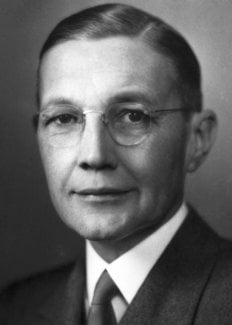Herbert S. Gasser
Biographical

Herbert Spencer Gasser was born in Platteville, Wisconsin, on July 5, 1888, the son of Herman Gasser end Jane Elisabeth Griswold. After attending the State Normal School he went on to the University of Wisconsin, where he graduated A.B. in 1910 and A.M. in 1911. Here he studied physiology under Dr. Erlanger, with whom he was later to have such a fruitful collaboration. He then went to the Johns Hopkins Medical School for his clinical studies, obtaining his M.D. in 1915. After a year in pharmacology at Wisconsin he went to Washington University (St. Louis), where he was associated with Dr. Erlanger, becoming Professor of Pharmacology in 1921.
From 1923-1925 he was granted leave of absence to study in Europe, working with Profs. A. V. Hill, W. Straub and L. Lapicque and Sir Henry Dale. In 1931 he was appointed Professor of Physiology and Head of the Medical Department at Cornell University, New York City. From 1935 to 1953 he was Director of the Rockefeller Institute for Medical Research, being later a member emeritus of the Institute.
When he was at Johns Hopkins Medical School, Dr. Gasser worked for a time on a problem concerning blood coagulation. His major work, however, dates from his collaboration with Prof. Erlanger and was concerned with the electrophysiology of the nerves. The first paper from him on the subject dealt with action currents in the phrenic nerve. Later, the newly perfected low – voltage cathode – ray oscillograph was utilized in the work. Soon it was possible to demonstrate that the complexity of the oscillograph results was due to the different conductivity rates of different groups of nerve fibres. The work led to advances in our knowledge of the mechanism of pain and of reflex action and has inspired a large school of neurophysiologists.
Dr. Gasser was a co-author of the book Electrical Signs of Nervous Activity (1937). He has also published, alone or with his collaborators, many scientific papers on neurophysical topics, being appointed an Editor of The Journal of Experimental Medicine in 1936.
He held honorary doctorates from the Universities of Pennsylvania, Rochester, Wisconsin, Columbia, Oxford, Harvard, Paris, Washington (St. Louis), and Johns Hopkins. He was a doctor, honoris causa, of the Free University of Brussels and of the University of Paris, and honorary M.D. of the Catholic University of Louvain. He was a member of the National Academy of Sciences (USA), the Philosophical Society, the Association of American Physicians (Kobel Medallist, 1954), the American Physiological Society, and many others. He held honorary memberships of the Physiological Society (Great Britain) and Asociación Médica Argentina. He was a foreign member of several learned societies, including the Royal Society (London). Dr. Gasser was also President of the Board of Directors of the Russel Sage Institute of Pathology. He was unmarried.
Dr Gasser died on May 11th, 1963.
This autobiography/biography was written at the time of the award and first published in the book series Les Prix Nobel. It was later edited and republished in Nobel Lectures. To cite this document, always state the source as shown above.
Nobel Prizes and laureates
Six prizes were awarded for achievements that have conferred the greatest benefit to humankind. The 12 laureates' work and discoveries range from proteins' structures and machine learning to fighting for a world free of nuclear weapons.
See them all presented here.
